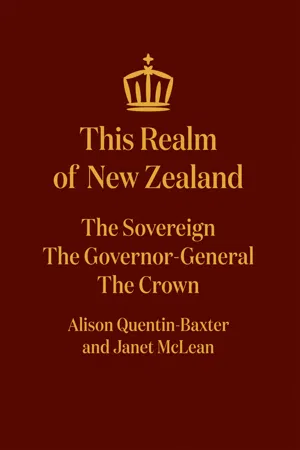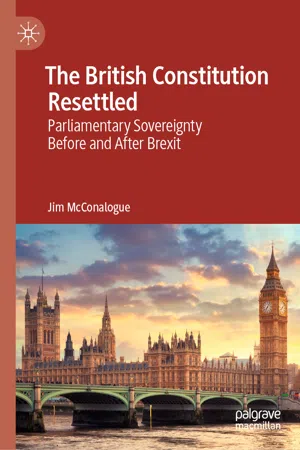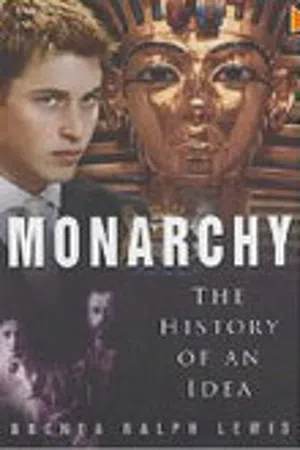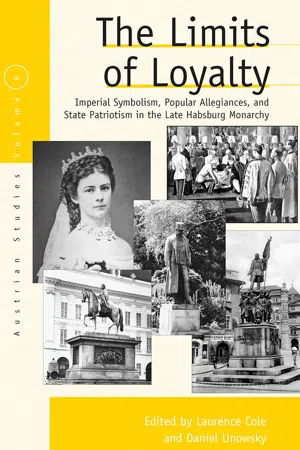History
Constitutional Monarchy
A constitutional monarchy is a form of government in which a monarch acts as the head of state within the parameters of a constitution. The powers of the monarch are limited by the constitution, which often includes a system of checks and balances. This system allows for a separation of powers and the establishment of a parliamentary government alongside the monarchy.
Written by Perlego with AI-assistance
Related key terms
5 Key excerpts on "Constitutional Monarchy"
- eBook - ePub
The Constitution of the United Kingdom
A Contextual Analysis
- Peter Leyland(Author)
- 2021(Publication Date)
- Hart Publishing(Publisher)
4Constitutional MonarchyMagna Carta – Royal Prerogative – Glorious Revolution – Abdication Crisis – Constitutional Monarchy – Head of State – The Crown – Defender of the Faith – Conferment of Honours – Liability in Contract and Tort – Preservation – AbolitionINTRODUCTIONT he united kingdom has a hereditary monarch as head of state. The Queen performs an important role as the personification of the nation. She appears on the national and international stage, and in this capacity she is often associated with occasions of pomp and ceremony that evoke memories of imperial glory. It is particularly this feature that distinguishes the British monarchy from its counterparts in the Netherlands, Belgium, and Scandinavia. However, as we shall see in the discussion that follows, although only limited power is exercised by the Queen on her own initiative, many constitutional functions still require her direct involvement. The path to Constitutional Monarchy has involved both the deliberate curtailment of royal power and its gradual erosion. The terminology is somewhat misleading. The government is still described as ‘Her Majesty’s government’, central government acts in the name of the Crown, and the courts are presided over by Her Majesty’s judges, but in modern times the monarch, although head of state, has a greatly subordinate constitutional role to Parliament, the government, and the courts. This is now accepted by reigning monarchs without question. In this chapter we will first discuss the institution of the monarchy, the royal prerogative, and the nature of the Crown as part of the current constitutional framework.During the Middle Ages and Tudor times kings and queens ruled through the exercise of the royal prerogative, but the idea that the powers of the monarch should be limited by law can be traced back at least as far as the Magna Carta of 1215. It was later established that general laws could not be made by way of proclamation – only Parliament could enact laws. It was also recognised that the King himself could not act as a judge, but must act through the judges in the courts. Since the Case of Proclamations1 it has been recognised that the scope of the prerogative can be determined by the courts.2 As we noted in Chapter 1 , the events of the seventeenth century, and in particular the Civil War 1642–49 and the ‘Glorious Revolution’ of 1688, are significant in English constitutional history because they signalled the decisive end of any pretensions to absolute monarchy, with most powers over legislation and delegated legislation eventually passing to Parliament. This coincided with the emergence of the doctrine of the supremacy of Parliament described by Dicey. This trend was reinforced in the eighteenth century with the Hanoverian succession of George I in 1714 to the throne, by which time ministers were directly responsible for the day-to-day running of government. The scope of government activity was then much more limited, with only a few Whitehall departments (such as the Treasury, the Foreign Office, and the Board of Trade), but as the foundations of the modern administrative state were laid in the late nineteenth and twentieth century, with the role of government being greatly expanded, so the monarch became increasingly peripheral to the central activities of the executive. In this sense, by the time of Queen Victoria it could be said of the monarch that: ‘she reigns but does not rule’.3 - eBook - ePub
This Realm of New Zealand
The Sovereign, the Governor-General, the Crown
- Janet McLean, Alison Quentin-Baxter(Authors)
- 2017(Publication Date)
- Auckland University Press(Publisher)
In this chapter we explain some of the underlying concepts and principles of the British constitutional system which New Zealand has inherited. They have been essential to the development and operation of the Constitutional Monarchy and will be discussed more fully in the later chapters — particularly Chapters 8 to 11. We also explain that some of the ideas historically associated with the monarchy of an earlier age never came to apply in New Zealand. That is true, as we will show, in respect of the Queen’s role in the tenure of land.2FROM MONARCHY TO Constitutional Monarchy
Any explanation of how a monarchical system developed into a Constitutional Monarchy begins in England — and long before the United Kingdom Government sent its representatives to Aotearoa/New Zealand.When George III, acting without or contrary to ministerial advice, tried to collect taxes from the North American colonies, they rebelled and declared themselves to be a republic. After winning the revolutionary war, the “Founding Fathers” drafted a constitution for the newly independent state. The Sovereign was replaced by what was, in effect, an elected King called the President who headed the executive branch of government. Influenced by Montesquieu’s arguments for the separation of the executive, legislative and judicial powers, the constitution provided for the separate election of the members of a bicameral legislature. It was essential to the framers of the US Constitution that there should be rivalry and contest between the executive and legislative branches of government. This was intended to create limits on government action.British political leaders reacted in their own way to George III’s attempts to act independently of his Ministers. He was the last British monarch to have such success in imposing his will. The Kings and Queens who followed sometimes had strong opinions which they made known to their Ministers, but, generally speaking, they observed what had come to be seen as their duty to act on the advice of their responsible advisers. Democracy was not achieved by a revolution or a completely new constitutional beginning but by a process of constitutional evolution. - eBook - ePub
The British Constitution Resettled
Parliamentary Sovereignty Before and After Brexit
- Jim McConalogue(Author)
- 2019(Publication Date)
- Palgrave Macmillan(Publisher)
The Crown-in-Parliament formulation therefore never really belonged only to the old constitution or to Dicey’s monolithic view which, for all its faults (discussed in Chapter 2), appeared overwhelmingly practical for judges and common lawyers and utilised throughout the legal and political establishment. Most importantly, the eight constitutional forms, including the most recent historical form, reinforce Marquand’s view of the constitution as a palimpsest. The principles and features of each of the eight constitutional forms described below illustrate the textual redrafting—the political pacts and major legislative and political precedents between each of the features within the forms—which in many ways help to grapple with the historical development of the constitutional forms. 3.1 The Making of the Present: Historical Transitions in Constitutional Conventions and Form 3.1.1 Constitutional Form One: ‘What the Crown-with-Magnates Enacts Is Law’ (1200–1350) The understanding of sovereignty as gubernaculum, government through the helm of the ship of state, can first be understood from the vantage point of the period of medieval kingship in the centuries preceding the Reformation in the thirteenth and fourteenth centuries (Harding 1993 ; Kantorowicz 1957 ; McIlwain 1947), if not more broadly to the reign of Anglo-Saxon monarch Athelstan (924–939) (History of Parliament Trust 2015, p. 12). That characterisation is expressed as divine monarchical sovereignty-with-magnates— divine in its claim to power and right but in consultation with magnates in council. In simple terms, the unequal theory of the ‘Crown rules’ model only ever really existed as an alternate model of unequal power—‘the Crown rules by consulting with magnates’ (Box 3.1). The Crown’s sovereignty within the helm of the ship of state is checked by barons (originally, the ‘Curia Regis’) - eBook - ePub
- Brenda Ralph Lewis(Author)
- 2011(Publication Date)
- The History Press(Publisher)
EIGHT
Constitutional Monarchy
D uring the nineteenth and into the twentieth century, when European thrones were largely monopolised by autocrats, the British monarchy was regarded, at best, as a paltry shadow of the world’s oldest and most prestigious form of government. From this viewpoint, British monarchs were tantamount to puppets. They bore magnificent titles: they were commanders of the armed forces, supreme governors of the Church of England, emperors of India and sovereigns over the world-wide British Empire, yet they had no power to act or make their own decisions in any of these capacities. They had been stripped of the royal prerogatives, which were now exercised by Parliament. They depended on Parliament for their pay. In politics, British monarchs were upstaged by prime ministers and their cabinets. At the same time, Parliament exercised a will of its own which, by law, could supervene that of the king.This was, of course, the highly prejudiced view of monarchs weaned on a diet of absolute power, God-given rights and deference that was little different from worship. Nevertheless, the limitations imposed on kings by Constitutional Monarchy were real enough. King Edward VII was given a sharp lesson in where the parameters lay after he came to the English throne in 1901. Edward was anxious to be an active monarch, concerning himself with government business and the workings of Parliament. No chance. The king was politely, but firmly, told to keep his hands off concerns that were beyond his purview. Politically, the involvement he planned would be seen as undue interference with the rights of the real rulers of Britain – the Members of Parliament and the voters who elected them.Emperors, kings and even dukes who ruled by Divine Right and imposed their will upon their realms were astounded at the way the king of England could be told what he could and could not do by his own subjects. To them, British Constitutional Monarchy was no more than a charade. What they did not realise was that this seemingly watered-down version of monarchy did not demean, but actually preserved the monarch: it raised him above embarrassing disputes, and separated him from the most common sources of friction – political rivalries, faction fighting, taxation, war and the sufferings and deprivations caused by war. - eBook - ePub
The Limits of Loyalty
Imperial Symbolism, Popular Allegiances, and State Patriotism in the Late Habsburg Monarchy
- Laurence Cole, Daniel Unowsky(Authors)
- 2007(Publication Date)
- Berghahn Books(Publisher)
Chapter 9REPRESENTING CONSTITUTIONAL MONARCHY IN LATE NINETEENTH AND EARLY TWENTIETH -CENTURY BRITAIN , GERMANY, AND AUSTRIA *
Christiane WolfUntil 1914, Europe was a continent dominated by monarchies. Even the new “nation-states” which emerged during the nineteenth century were founded as monarchies. Despite the obvious persistence of dynastic states, however, there have been relatively few sustained efforts at examining how monarchies met the challenges of modern society, chief among them being the idea of “the nation” and the force of nationalism. In short, the “nationalization” of society became an existential question for numerous states including the British Empire, the new German Empire, and the multinational Habsburg Monarchy.Over the last decade and more, a growing body of work has begun to explore the issue of how effectively dynasties could act as sources of integration in a changing social and political environment by looking at such phenomena as royal ceremonies and public rituals, the changing image of individual rulers, and the constitutional and political role played by the monarch.1 Yet, if this work generally points to a remarkable popularity of European monarchs around the end of the nineteenth century, it must be noted that very little of it is explicitly comparative in nature.2 As a result, long standing assumptions regarding the differences between “Western” constitutional monarchies and “Eastern” autocracies have not been subjected to close analysis and overlap in many respects with the traditional distinctions made between Western European “civic nationalism” and Eastern European “ethnic nationalism.”Such observations are especially pertinent to the history of the Habsburg Monarchy, given that both contemporaries and later generations have viewed the nationalities question as the fundamental problem for the multinational state. Whereas nationalism framed in the context of an imperial mission might increase the popularity of the German and British monarchs, nationalism posed a direct threat to the very existence of Austria-Hungary. According to an article on the Habsburg Monarchy published in the left-liberal Berliner Tagblatt in 1913, Austria-Hungary was the only great power of Europe that was not a nation-state. Instead of national homogeneity bolstering state unity, Austria-Hungary’s fifty-two million inhabitants were riven by national divisions: some twelve million Germans, ten million Hungarians, three million Romanians, and twenty-six million Slavs, divided into many different national groups, lived in the chaotic Habsburg polity. For this Berlin-based newspaper, the “Panslavism” of the Bohemians, the rise of “south Slavic nationalism,” and the establishment of the Magyars as the “ruling nation” in Hungary constituted serious threats to the survival of the state.3 Just as Joseph Roth illustrated in his 1932 novel, The Radetzky March, standard works on the Habsburg Monarchy underscore the “unstoppable and undeniable” yearning of the nationalities for independence, a wish that could not in the end be fulfilled within the structure of the monarchy.4
Learn about this page
Index pages curate the most relevant extracts from our library of academic textbooks. They’ve been created using an in-house natural language model (NLM), each adding context and meaning to key research topics.




